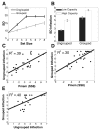Selection and storage of perceptual groups is constrained by a discrete resource in working memory
- PMID: 23067117
- PMCID: PMC4068940
- DOI: 10.1037/a0030094
Selection and storage of perceptual groups is constrained by a discrete resource in working memory
Retraction in
-
Retraction of Anderson et al. (2013).J Exp Psychol Hum Percept Perform. 2015 Oct;41(5):1189. doi: 10.1037/xhp0000136. Epub 2015 Aug 17. J Exp Psychol Hum Percept Perform. 2015. PMID: 26280271 Free PMC article.
Abstract
Perceptual grouping can lead observers to perceive a multielement scene as a smaller number of hierarchical units. Past work has shown that grouping enables more elements to be stored in visual working memory (WM). Although this may appear to contradict so-called discrete resource models that argue for fixed item limits in WM storage, it is also possible that grouping reduces the effective number of "items" in the display. To test this hypothesis, we examined how mnemonic resolution declined as the number of items to be stored increased. Discrete resource models predict that precision will reach a stable plateau at relatively early set sizes, because no further items can be stored once putative item limits are exceeded. Thus, we examined whether the precision by set size function was bilinear when storage was enhanced via perceptual grouping. In line with the hypothesis that each perceptual group counted as a single "item," precision still reached a clear plateau at a set size determined by the number of stored groups. Moreover, the maximum number of elements stored was doubled, and electrophysiological measures showed that selection and storage-related neural responses were the same for a single element and a multielement perceptual group. Thus, perceptual grouping allows more elements to be held in working memory while storage is still constrained by a discrete item limit.
Figures







Comment in
-
Findings of research misconduct.NIH Guide Grants Contracts (Bethesda). 2015 Aug 14:NOT-OD-15-141. NIH Guide Grants Contracts (Bethesda). 2015. PMID: 26306340 Free PMC article. No abstract available.
-
Findings of Research Misconduct.Fed Regist. 2015 Jul 31;80(147):45661-45662. Fed Regist. 2015. PMID: 27737259 Free PMC article. No abstract available.
References
Publication types
MeSH terms
Grants and funding
LinkOut - more resources
Full Text Sources
Other Literature Sources
Miscellaneous

